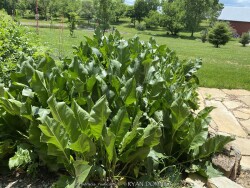

Horseradish (Armoracia rusticana) is a large tropical looking plant features large, variably sized 18-24" long, shiny, dark green leaves (resembling Silphium). It is also a perennial vegetable that is grown for its pungent, fleshy roots which are harvested and grated to make sauces. Insignificant, whitish flowers which appear in summer. Beware that this is an extremely vigorous plant that crowds out most weeds and is itself weed-like, with a very spreading growth habit. Best planted and allowed to grow as large isolated clumps, mowing around it generally stops the yearly spread. Included in our "edibles" plant database section.


Red chokeberry (Aronia arbutifolia 'Brilliantissima'), is an open, upright, spreading, somewhat rounded but leggy, suckering, deciduous shrub that typically grows 6-10' tall. It is native to native to both wet and dry thickets in Eastern North America. This 3-season shrub had appeal from spring to late fall starting with white flowers, then deep green summer foliage followed by brilliant red fall color and red berries. Plant in groups or mass plantings in small gardens or open woodland areas. Ability to withstand wet conditions makes it suitable for growing on the margins of ponds, streams, or rain gardens. Watch out for deer can devour young plants (protect with chicken wire if needed) but established plantings can generally outgrow deer browsing which offer free pruning to prevent legginess. The common name of chokeberry is in reference to the tart and bitter taste of the fruits which are edible but so astringent as to cause choking in most of those who try: no it's not poison!. Fruits are renowned for its antioxidant rich berries and high nutritional value and sometimes used to make tasty jams and jellies if enough sugar is added. Included in our "edibles" database but depends on how hungry you are! Aronia arbutifolia 'Brilliantissima' grows slowly to 6-8' tall and is perhaps most noted for its attractive glossy red berries and red fall foliage color. It primarily differs from the species by being more compact. It producing more lustrous foliage with superior red fall color. It also produces larger, glossier and more abundant fruit favored by wildlife.
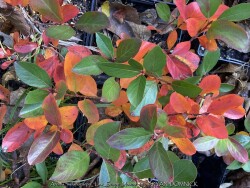

Low Scape Mound Aronia (Aronia melanocarpa 'Low Scape Mound') is a tidy little mound shaped deciduous shrub that typically grows 1-2' tall. It is native to low woods, swamps, bogs and moist thickets native from the Midwest to Canada. This 3-season shrub had appeal from spring to late fall starting with white flowers, then deep green summer foliage followed by brilliant red fall color and a few blackberries. Plant in small groups or mass plantings in small gardens. Ability to withstand wet conditions makes it suitable for growing on the margins of ponds, streams, or rain gardens. Despite 'Low Scape Mound' being touted as "drought tolerant", in the southern part of their range (Kansas), this chokeberry will decline in dry clay or alkaline soils. Watch out for deer and rabbits can devour young plants (protect with chicken wire if needed) but established plantings can generally outgrow browsing. The common name of chokeberry is in reference to the tart and bitter taste of the fruits which are edible but so astringent as to cause choking in most of those who try: no it's not poison!. Fruits are renowned for its antioxidant rich berries and high nutritional value and sometimes used to make tasty jams and jellies if enough sugar is added. Included in our "edibles" database but depends on how hungry you are! However, 'Low Scape Mound' is not grown for fruit production but rather as a compact landscape 3-season shrub tolerant of wet soils. All Proven Winners® plants are legally propagated, healthy and vigorous, true to name, and tagged with color pictures and growing information.
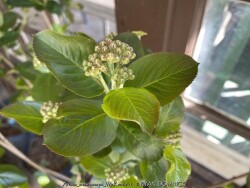

Black Chokeberry (Aronia melanocarpa), is an open, upright, spreading, somewhat rounded but leggy, suckering, deciduous shrub that typically grows 3-6' tall. It is native to low woods, swamps, bogs and moist thickets native from the Midwest to Canada. This 3-season shrub had appeal from spring to late fall starting with white flowers, then deep green summer foliage followed by brilliant red fall color and black berries. Plant in groups or mass plantings in small gardens or open woodland areas. Ability to withstand wet conditions makes it suitable for growing on the margins of ponds, streams, or rain gardens. Watch out for deer can devour young plants (protect with chicken wire if needed) but established plantings can generally outgrow deer browsing which offer free pruning to prevent legginess. The common name of chokeberry is in reference to the tart and bitter taste of the fruits which are edible but so astringent as to cause choking in most of those who try: no it's not poison!. Fruits are renowned for its antioxidant rich berries and high nutritional value and sometimes used to make tasty jams and jellies if enough sugar is added. Included in our "edibles" database but depends on how hungry you are! Aronia melanocarpa 'McKenzie' black chokeberry produces abundant fruit and improved fall color.
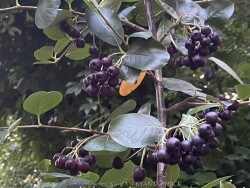

Black Chokeberry (Aronia melanocarpa), is an open, upright, spreading, somewhat rounded but leggy, suckering, deciduous shrub that typically grows 3-6' tall. It is native to low woods, swamps, bogs and moist thickets native from the Midwest to Canada. This 3-season shrub had appeal from spring to late fall starting with white flowers, then deep green summer foliage followed by brilliant red fall color and black berries. Plant in groups or mass plantings in small gardens or open woodland areas. Ability to withstand wet conditions makes it suitable for growing on the margins of ponds, streams, or rain gardens. Watch out for deer can devour young plants (protect with chicken wire if needed) but established plantings can generally outgrow deer browsing which offer free pruning to prevent legginess. The common name of chokeberry is in reference to the tart and bitter taste of the fruits which are edible but so astringent as to cause choking in most of those who try: no it's not poison!. Fruits are renowned for its antioxidant rich berries and high nutritional value and sometimes used to make tasty jams and jellies if enough sugar is added. Included in our "edibles" database but depends on how hungry you are! 'Viking' was developed in Europe for production of extra large dark purple-black fruit also used as a component of health drink juices. Aronia melanocarpa 'Viking' black chokeberry produces abundant fruit and improved fall color. Cross pollination on both varieties increases fruit production although both are self-fertile.
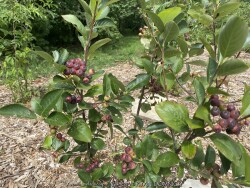

Black Chokeberry (Aronia melanocarpa), is an open, upright, spreading, somewhat rounded but leggy, suckering, deciduous shrub that typically grows 3-6' tall. It is native to low woods, swamps, bogs and moist thickets native from the Midwest to Canada. This 3-season shrub had appeal from spring to late fall starting with white flowers, then deep green summer foliage followed by brilliant red fall color and black berries. Plant in groups or mass plantings in small gardens or open woodland areas. Ability to withstand wet conditions makes it suitable for growing on the margins of ponds, streams, or rain gardens. Watch out for deer can devour young plants (protect with chicken wire if needed) but established plantings can generally outgrow deer browsing which offer free pruning to prevent legginess. The common name of chokeberry is in reference to the tart and bitter taste of the fruits which are edible but so astringent as to cause choking in most of those who try: no it's not poison!. Fruits are renowned for its antioxidant rich berries and high nutritional value and sometimes used to make tasty jams and jellies if enough sugar is added. Included in our "edibles" database but depends on how hungry you are! 'Viking' was developed in Europe for production of extra large dark purple-black fruit also used as a component of health drink juices.
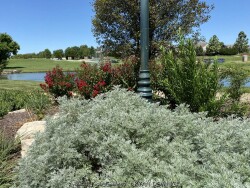

Powis Castle Artemisia (Artemisia 'Powis Castle') beautiful drought tolerant woody perennial valued for its finely dissected, aromatic, silver-gray foliage. It is evergreen down to 0 degrees F, if colder than -5degrees F, woody growth dies back too. Flowering is non-existant. As a perfect companion to vibrant flowering plants and ornamental grasses, it adds unique contrasting color and texture to waterwise landscapes. Most artemisias are best grown in poor to moderately fertile, dry to medium moisture, well-drained soils in full sun. In order to avoid occasional winter-kill in Kansas landscapes, it is advisable to plant on a south, east or west side of house or on south facing slopes or berms. Excellent soil drainage is essential for growing this plant well as poor lanky growth and root rot will occur in moist to wet soils. Tolerant of part-shade if kept dry. Cut back to 3-6" in early spring after dried winter silvery foliage stops looking attractive. New growth will emerge from the crown in mid-spring. If low temperatures hit -10 degrees F, it may kill an un-mulched plant; protect any zone 6 perennial with thick layer of mulch. General foliage decline may occur in hot and humid summer climates of the Southeast US but this is rarely a problem in Kansas or Oklahoma.
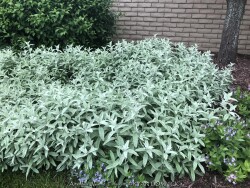

Valerie Finnis Wormwood (Artemisia ludoviciana 'Valerie Finnis') is a beautiful drought tolerant woody perennial valued for its silver-gray foliage. Most artemisias are best grown in poor to moderately fertile, dry to medium moisture, well-drained soils in full sun. Excellent soil drainage is essential for growing this plant well as poor lanky growth and root rot will occur in moist to wet soils. General foliage decline may occur in hot and humid summer climates but this is rarely a problem in Kansas or Oklahoma. Beware that this is an extremely vigorous plant that crowds out most weeds and is itself weed-like, with a very spreading underground rhizome system. Best planted and allowed to grow as large isolated clumps, mowing around it generally stops the yearly spread. In Kansas landscapes, it may be used as a mass planting groundcover in front of taller contrasting blooming shrubs such as crape myrtles, vitex, smoke bushes, or roses.
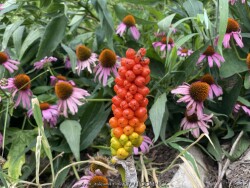

Italian Painted Arum (Arum italicum 'Pictum') is native to the Mediterranean region. It has a reversed or off-schedule life cycle; growing when other plants have already shed their leaves to take advantage of sunlight and lack of competition. It is often planted for its unusual evergreen leaf pattern and color resembling a bright green house plant growing outside in winter. Foliage goes dormant by June but is followed by naked stalks emerging from the ground with reddish orange berries. Foliage re-appears in fall and lasts well into winter untouched. If low temperatures hit 0 degrees F, foliage finally dies back to the ground and re-emerges in early spring to repeat the life cycle. If low temperatures hit -15 degrees F, it may kill an un-mulched plant; protect any zone 5/6 perennial with a 2-3" thick layer of mulch. Grow in average to rich well drained garden soil in full sun or full shade with everything in between. Moderate dry shade does not seem to be a problem because arum goes dormant anyways in the heat of summer. This holds true for planting in sunny locations to. Combine with shade garden plants that will fill the space in summer such as hostas or solomon seal. Also great when combined with late-emerging spring perennials (like plumbago, hardy hibiscus, and orange butterfly weed) because it fills that early spring space starting to grow extremely early with freeze-resistant foliage. Then later in the summer when Arum goes dormant, these plants hide the dying foliage and void left in the garden; what a great way for two species to share the same garden space! It has potential to be invasive in parts of the country such as the Pacific Northeast USA but not in Kansas. It is very stable but does not self-seed or spread in Lawrence, KS gardens; bulb offsets develop but only thicken the existing clump over time. Considered to be a great permatanet multi-season perennial for your garden.


Arundinaria gigantea is also called Canebrake (a tall thicket of any of a variety of Arundinaria) This species, along with its shorter form, 'Tecta', are the only bamboos native to the United States. It once covered huge swaths of rich bottomland along stream valleys and ravines throughout the southeastern United States but have been widely replaced by agriculture. Although still seen in small patches, it can reproduce asexually and rapidly. This adaptation that allows them to persist quietly in the shade of a forest for years and rapidly take advantage of disturbance which disrupts the overstory, such as blowdowns, floods or hurricanes. As a landscape plant, use the same as you would use oriental bamboo in large areas for a evergreen noise, wind, visual screening. Foliage is evergreen to 0 to 5 degrees F. Canes will defoliate at -5 to -10 degrees F. Canes die to the ground at -10 to -15 degrees. Root system will survive up to -25 to -30 degrees F as a perennial especially if mulched. Arundinaria gigantea usually grows 10-15' feet tall in Kansas. Every few years a grove will experience complete winterkill: it is strongly advised to cut all dead growth to the ground for aesthetic reasons and and fire prevention. The 'Tecta' form looks similar but only grows 6-8 feet tall and is tolerant of wet soil.
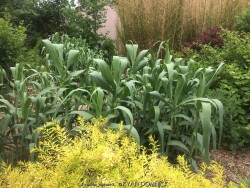

Giant Reed Grass (Arundo donax) is a giant perennial grass that can reach up to 20 ft. in height in Kansas in average to wet soils. Although it can be much shorter in full to part shade or very dry soils. The overall look is tropical like resembling giant corn. Flowering occurs in late summer to early fall, when plants are most easily recognized because of the large, dense flower plumes (upto 3' long) that develop at the tops of the culms. Arundo donax is native to India and spreads through rhizomes and stem nodes that come in contact with the soil. If low temperatures hit -10 degrees F, it may kill an un-mulched plant; protect any zone 6 perennial with thick layer of mulch. It has potential to be invasive in parts of the country but not so much in Kansas as cold winters prevent this plant from self-seeding and taking over ecosystems. Maintenance can be quite a yearly chore cutting back 20' tall cans each year; we recommend a chainsaw, heavy-duty loppers, and a large burn pit. Canes pop (but don't spark) when burning in bonfires! Make your very own firework sound effects; lots of fun with our kids! Cut-back is best in the fall because canes shed leaves stalks making a mess when winter winds blow. For the home garden, the species is generally too aggressive to mix with other plants or near the house: plan on its use as a screening plant and allow at least a 10'x10' area. One of the best plants for screening busy highways in rough non-irrigated areas.
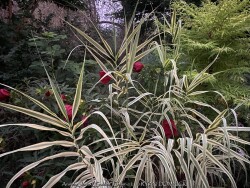

Golden Chain is a dwarf Giant Reed Grass cultivar (Arundo donax 'Golden Chain') is a perennial grass that can reach up to 8 ft. in height in Kansas in average to wet soils. Although it can be much shorter in part shade or very dry soils. The overall look is tropical like resembling corn. Flowering occurs in late summer to early fall, when plants are most easily recognized because of the large, dense flower plumes (upto 2' long) that develop at the tops of the culms. Arundo donax is native to India and spreads through rhizomes and stem nodes that come in contact with the soil. If low temperatures hit -10 degrees F, it may kill an un-mulched plant; protect any zone 6 perennial with thick layer of mulch. The non-variegated species has potential to be invasive in parts of the country but not so much in Kansas as cold winters prevent this plant from self-seeding and taking over ecosystems. Cut-back is best in the fall because canes shed leaves stalks making a mess when winter winds blow. Canes pop (but don't spark) when burning in bonfires! Make your very own firework sound effects; lots of fun with our kids! For the home garden, Golden Chain Dwarf Giant Reed Grass is much less aggressive than the species; you can mix it with other plants near the house or in rain gardens. Large clumps have been stable in our Lawrence, KS (zone 6a) display garden for over 5 years; spread is quite slow and manageable.
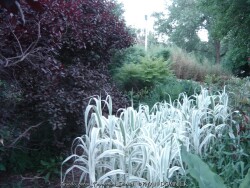

Golden Chain is a dwarf Giant Reed Grass cultivar (Arundo donax 'Golden Chain') This arundo cultivar (Arundo donax 'Peppermint Stick') is a perennial grass that can reach up to 12 ft. in height in Kansas in average to wet soils. Although it can be much shorter in full to part shade or very dry soils. The overall look is tropical like resembling giant corn. Flowering occurs in late summer to early fall, when plants are most easily recognized because of the large, dense flower plumes (upto 3' long) that develop at the tops of the culms. Arundo donax is native to India and spreads through rhizomes and stem nodes that come in contact with the soil. If low temperatures hit -10 degrees F, it may kill an un-mulched plant; protect any zone 6 perennial with thick layer of mulch. The non-variegated species has potential to be invasive in parts of the country but not so much in Kansas as cold winters prevent this plant from self-seeding and taking over ecosystems. Cut-back is best in the fall because canes shed leaves stalks making a mess when winter winds blow. Canes pop (but don't spark) when burning in bonfires! Make your very own firework sound effects; lots of fun with our kids! For the home garden, Peppermint Stick Giant Reed Grass is less aggressive than the species; you can mix it with other plants near the house or in rain gardens. Peppermint Stick maintains it's variegation unlike older variegated cultivars and does not revert or fade to green! Large clumps have been stable in our Lawrence, KS (zone 6a) display garden for over a decade; spread is quite slow and manageable.
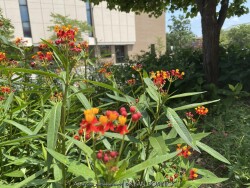

***Description for this plant available with future update!***
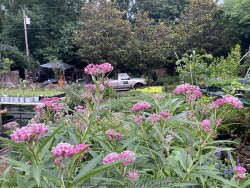

Pink Swamp Milkweed (Asclepias incarnata) is a herbaceous perennial plant species native to North America. The foliage is bright green and upright. The blooms occurring in early to mid-summer are pink to mauve (sometimes white). After blooming, green seed pods are attractive. They finally split open in late summer releasing silver fluffy floating seeds that are whisked away in the wind. This same natural mechanism for seed dispersal is similar to that used by most other milkweed (Asclepias) species. Fall color is an attractive yellow to gold with red highlights. It is frequently grown as a bog plant needing constantly moist soil rich in organic matter. As a rain garden plant, it will thrive is a depressed area in the landscape that collects rain water from a roof during spring and summer periods of rain but then go dormant if the water hole dries out completely. This species is not shade-tolerant and will get crowded out if the rain garden becomes too dense. Pink Swamp Milkweed may also be grown in average garden soils provided extra water is supplied during droughts. It is cultivated as a garden plant for butterflies and birds at all life stages: foliage for caterpillars, nectar for butterflies and other insects, and seeds for birds. It has a latex sap containing toxic chemicals that helps it repel other insects and other herbivorous animals. In the home landscape, this species does not spread like some other milkweeds. The plant is also timid about self-seeding because seeds have to germinate in mud and quickly die if it dries out. No worries about invasiveness with this one, just count on it being a beautiful tall perennial for many years in the garden! The species is not shade-tolerant and is not a good vegetative competitor.
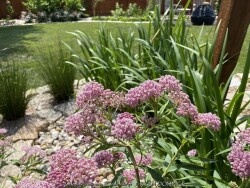

Pink Swamp Milkweed (Asclepias incarnata) is a herbaceous perennial plant species native to North America. The foliage is bright green and upright. The blooms occurring in early to mid-summer are pink to mauve (sometimes white). After blooming, green seed pods are attractive. They finally split open in late summer releasing silver fluffy floating seeds that are whisked away in the wind. This same natural mechanism for seed dispersal is similar to that used by most other milkweed (Asclepias) species. Fall color is an attractive yellow to gold with red highlights. It is frequently grown as a bog plant needing constantly moist soil rich in organic matter. As a rain garden plant, it will thrive is a depressed area in the landscape that collects rain water from a roof during spring and summer periods of rain but then go dormant if the water hole dries out completely. This species is not shade-tolerant and will get crowded out if the rain garden becomes too dense. Pink Swamp Milkweed may also be grown in average garden soils provided extra water is supplied during droughts. It is cultivated as a garden plant for butterflies and birds at all life stages: foliage for caterpillars, nectar for butterflies and other insects, and seeds for birds. It has a latex sap containing toxic chemicals that helps it repel other insects and other herbivorous animals. In the home landscape, this species does not spread like some other milkweeds. The plant is also timid about self-seeding because seeds have to germinate in mud and quickly die if it dries out. No worries about invasiveness with this one, just count on it being a beautiful tall perennial for many years in the garden! The species is not shade-tolerant and is not a good vegetative competitor.
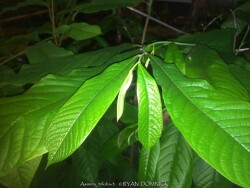

Paw Paw (Asimina triloba) is a tropical looking native understory fruit tree with large green leaves and delicious fruits. Flowers are born on old wood in the early spring and the maroon color is common of flowers meant to attract flies for pollination. Foliage is up to 12 inches long and turns a brilliant yellow in autumn for a couple weeks before falling. If cross pollination occurs, delicious fruits are produced in small clusters. The texture is custard like and taste is a mix between banana, mango, and hint of pineapple. Fruit is very fragile upon ripening and will fall to the ground and splat or be quickly devoured by animals. It is suggested that you put fruit nets around the clusters of fruit or harvest a few days earlier and allow to ripen inside. Fruit is rarely commercially available due to its fragility and short shelf-life. Cleaned fruit may be peeled frozen with seed intact: they can be picked out much easier when thawed out again Paw Paw may be eaten fresh, baked into desserts, or made into ice cream. Paw Paw is native to a large geographical area over eastern United States including Kansas. In the wild, Paw Paw grows in moist rich forest valleys in full to part shade. Best fruiting specimens can also be found on the edge of woodland or clearing in rich soil. Paw Paw tree colonies slowly spread by rhizomes and seem to occupy the forest understory sometimes for decades or centuries waiting for an opening to allow sunlight in. If a large canopy tree (such as an oak) dies or wind storm rolls through clearing a patch, new sunlight and an opening in the canopy occurs paving the way for sexual reproduction to take place (fruits) Paw Paw is somewhat tolerant of poorly drained soil's including clay but growth will be much slower. Interestingly, Paw Paws will tolerate and even need full sun when older to produce fruit. However, young saplings will quickly die in full sun from leaf burn and drought stress. If a tree is at least 4 to 6 tall and is planted in rich soil and full sun with regular irrigation, it will probably be fine. With these growing conditions, trees may grow at a median growth rate instead of slow, putting up 1 to 2 feet of new growth per year. If you have the right conditions for a Paw Paw tree, it should definitely be a part of your landscape whether you are growing for fruit production or not. There are dozens on improved cultivars available now days. In our Lawrence, KS display gardens, we are trialing several of these improved fruiting cultivars from Forrest Keeling Nursery in Missouri.
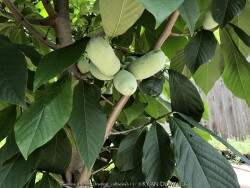

Paw Paw (Asimina triloba) is a tropical looking native understory fruit tree with large green leaves and delicious fruits. Flowers are born on old wood in the early spring and the maroon color is common of flowers meant to attract flies for pollination. Foliage is up to 12 inches long and turns a brilliant yellow in autumn for a couple weeks before falling. If cross pollination occurs, delicious fruits are produced in small clusters. The texture is custard like and taste is a mix between banana, mango, and hint of pineapple. Fruit is very fragile upon ripening and will fall to the ground and splat or be quickly devoured by animals. It is suggested that you put fruit nets around the clusters of fruit or harvest a few days earlier and allow to ripen inside. Fruit is rarely commercially available due to its fragility and short shelf-life. Cleaned fruit may be peeled frozen with seed intact: they can be picked out much easier when thawed out again Paw Paw may be eaten fresh, baked into desserts, or made into ice cream. Paw Paw is native to a large geographical area over eastern United States including Kansas. In the wild, Paw Paw grows in moist rich forest valleys in full to part shade. Best fruiting specimens can also be found on the edge of woodland or clearing in rich soil. Paw Paw tree colonies slowly spread by rhizomes and seem to occupy the forest understory sometimes for decades or centuries waiting for an opening to allow sunlight in. If a large canopy tree (such as an oak) dies or wind storm rolls through clearing a patch, new sunlight and an opening in the canopy occurs paving the way for sexual reproduction to take place (fruits) Paw Paw is somewhat tolerant of poorly drained soil's including clay but growth will be much slower. Interestingly, Paw Paws will tolerate and even need full sun when older to produce fruit. However, young saplings will quickly die in full sun from leaf burn and drought stress. If a tree is at least 4 to 6 tall and is planted in rich soil and full sun with regular irrigation, it will probably be fine. With these growing conditions, trees may grow at a median growth rate instead of slow, putting up 1 to 2 feet of new growth per year. If you have the right conditions for a Paw Paw tree, it should definitely be a part of your landscape whether you are growing for fruit production or not. There are dozens on improved cultivars available now days. In our Lawrence, KS display gardens, we are trialing several of these improved fruiting cultivars from Forrest Keeling Nursery in Missouri. Asimina triloba 'Allegheny' is one of the earliest pawpaw trees to ripen. Compared to other varieties, the fruit may be smaller, but its productivity in terms of number of fruits is more than abundant!
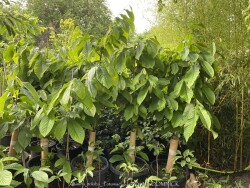

Paw Paw (Asimina triloba) is a tropical looking native understory fruit tree with large green leaves and delicious fruits. Flowers are born on old wood in the early spring and the maroon color is common of flowers meant to attract flies for pollination. Foliage is up to 12 inches long and turns a brilliant yellow in autumn for a couple weeks before falling. If cross pollination occurs, delicious fruits are produced in small clusters. The texture is custard like and taste is a mix between banana, mango, and hint of pineapple. Fruit is very fragile upon ripening and will fall to the ground and splat or be quickly devoured by animals. It is suggested that you put fruit nets around the clusters of fruit or harvest a few days earlier and allow to ripen inside. Fruit is rarely commercially available due to its fragility and short shelf-life. Cleaned fruit may be peeled frozen with seed intact: they can be picked out much easier when thawed out again Paw Paw may be eaten fresh, baked into desserts, or made into ice cream. Paw Paw is native to a large geographical area over eastern United States including Kansas. In the wild, Paw Paw grows in moist rich forest valleys in full to part shade. Best fruiting specimens can also be found on the edge of woodland or clearing in rich soil. Paw Paw tree colonies slowly spread by rhizomes and seem to occupy the forest understory sometimes for decades or centuries waiting for an opening to allow sunlight in. If a large canopy tree (such as an oak) dies or wind storm rolls through clearing a patch, new sunlight and an opening in the canopy occurs paving the way for sexual reproduction to take place (fruits) Paw Paw is somewhat tolerant of poorly drained soil's including clay but growth will be much slower. Interestingly, Paw Paws will tolerate and even need full sun when older to produce fruit. However, young saplings will quickly die in full sun from leaf burn and drought stress. If a tree is at least 4 to 6 tall and is planted in rich soil and full sun with regular irrigation, it will probably be fine. With these growing conditions, trees may grow at a median growth rate instead of slow, putting up 1 to 2 feet of new growth per year. If you have the right conditions for a Paw Paw tree, it should definitely be a part of your landscape whether you are growing for fruit production or not. There are dozens on improved cultivars available now days. In our Lawrence, KS display gardens, we are trialing several of these improved fruiting cultivars from Forrest Keeling Nursery in Missouri.


Paw Paw (Asimina triloba) is a tropical looking native understory fruit tree with large green leaves and delicious fruits. Flowers are born on old wood in the early spring and the maroon color is common of flowers meant to attract flies for pollination. Foliage is up to 12 inches long and turns a brilliant yellow in autumn for a couple weeks before falling. If cross pollination occurs, delicious fruits are produced in small clusters. The texture is custard like and taste is a mix between banana, mango, and hint of pineapple. Fruit is very fragile upon ripening and will fall to the ground and splat or be quickly devoured by animals. It is suggested that you put fruit nets around the clusters of fruit or harvest a few days earlier and allow to ripen inside. Fruit is rarely commercially available due to its fragility and short shelf-life. Cleaned fruit may be peeled frozen with seed intact: they can be picked out much easier when thawed out again Paw Paw may be eaten fresh, baked into desserts, or made into ice cream. Paw Paw is native to a large geographical area over eastern United States including Kansas. In the wild, Paw Paw grows in moist rich forest valleys in full to part shade. Best fruiting specimens can also be found on the edge of woodland or clearing in rich soil. Paw Paw tree colonies slowly spread by rhizomes and seem to occupy the forest understory sometimes for decades or centuries waiting for an opening to allow sunlight in. If a large canopy tree (such as an oak) dies or wind storm rolls through clearing a patch, new sunlight and an opening in the canopy occurs paving the way for sexual reproduction to take place (fruits) Paw Paw is somewhat tolerant of poorly drained soil's including clay but growth will be much slower. Interestingly, Paw Paws will tolerate and even need full sun when older to produce fruit. However, young saplings will quickly die in full sun from leaf burn and drought stress. If a tree is at least 4 to 6 tall and is planted in rich soil and full sun with regular irrigation, it will probably be fine. With these growing conditions, trees may grow at a median growth rate instead of slow, putting up 1 to 2 feet of new growth per year. If you have the right conditions for a Paw Paw tree, it should definitely be a part of your landscape whether you are growing for fruit production or not. There are dozens on improved cultivars available now days. In our Lawrence, KS display gardens, we are trialing several of these improved fruiting cultivars from Forrest Keeling Nursery in Missouri. Asimina triloba 'Pennsylvania Gold' produces good crop of medium to large fruits with sweet, flavorful flesh. It is one of the earliest ripening varieties.


Paw Paw (Asimina triloba) is a tropical looking native understory fruit tree with large green leaves and delicious fruits. Flowers are born on old wood in the early spring and the maroon color is common of flowers meant to attract flies for pollination. Foliage is up to 12 inches long and turns a brilliant yellow in autumn for a couple weeks before falling. If cross pollination occurs, delicious fruits are produced in small clusters. The texture is custard like and taste is a mix between banana, mango, and hint of pineapple. Fruit is very fragile upon ripening and will fall to the ground and splat or be quickly devoured by animals. It is suggested that you put fruit nets around the clusters of fruit or harvest a few days earlier and allow to ripen inside. Fruit is rarely commercially available due to its fragility and short shelf-life. Cleaned fruit may be peeled frozen with seed intact: they can be picked out much easier when thawed out again Paw Paw may be eaten fresh, baked into desserts, or made into ice cream. Paw Paw is native to a large geographical area over eastern United States including Kansas. In the wild, Paw Paw grows in moist rich forest valleys in full to part shade. Best fruiting specimens can also be found on the edge of woodland or clearing in rich soil. Paw Paw tree colonies slowly spread by rhizomes and seem to occupy the forest understory sometimes for decades or centuries waiting for an opening to allow sunlight in. If a large canopy tree (such as an oak) dies or wind storm rolls through clearing a patch, new sunlight and an opening in the canopy occurs paving the way for sexual reproduction to take place (fruits) Paw Paw is somewhat tolerant of poorly drained soil's including clay but growth will be much slower. Interestingly, Paw Paws will tolerate and even need full sun when older to produce fruit. However, young saplings will quickly die in full sun from leaf burn and drought stress. If a tree is at least 4 to 6 tall and is planted in rich soil and full sun with regular irrigation, it will probably be fine. With these growing conditions, trees may grow at a median growth rate instead of slow, putting up 1 to 2 feet of new growth per year. If you have the right conditions for a Paw Paw tree, it should definitely be a part of your landscape whether you are growing for fruit production or not. There are dozens on improved cultivars available now days. In our Lawrence, KS display gardens, we are trialing several of these improved fruiting cultivars from Forrest Keeling Nursery in Missouri. Asimina triloba 'Potomac' has large, fleshy fruits with sweet, rich flavor and firm, smooth texture. This tree has a more upright habit that other pawpaw varieties.
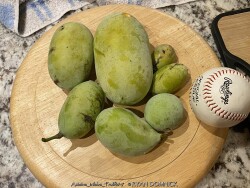

Paw Paw (Asimina triloba) is a tropical looking native understory fruit tree with large green leaves and delicious fruits. Flowers are born on old wood in the early spring and the maroon color is common of flowers meant to attract flies for pollination. Foliage is up to 12 inches long and turns a brilliant yellow in autumn for a couple weeks before falling. If cross pollination occurs, delicious fruits are produced in small clusters. The texture is custard like and taste is a mix between banana, mango, and hint of pineapple. Fruit is very fragile upon ripening and will fall to the ground and splat or be quickly devoured by animals. It is suggested that you put fruit nets around the clusters of fruit or harvest a few days earlier and allow to ripen inside. Fruit is rarely commercially available due to its fragility and short shelf-life. Cleaned fruit may be peeled frozen with seed intact: they can be picked out much easier when thawed out again Paw Paw may be eaten fresh, baked into desserts, or made into ice cream. Paw Paw is native to a large geographical area over eastern United States including Kansas. In the wild, Paw Paw grows in moist rich forest valleys in full to part shade. Best fruiting specimens can also be found on the edge of woodland or clearing in rich soil. Paw Paw tree colonies slowly spread by rhizomes and seem to occupy the forest understory sometimes for decades or centuries waiting for an opening to allow sunlight in. If a large canopy tree (such as an oak) dies or wind storm rolls through clearing a patch, new sunlight and an opening in the canopy occurs paving the way for sexual reproduction to take place (fruits) Paw Paw is somewhat tolerant of poorly drained soil's including clay but growth will be much slower. Interestingly, Paw Paws will tolerate and even need full sun when older to produce fruit. However, young saplings will quickly die in full sun from leaf burn and drought stress. If a tree is at least 4 to 6 tall and is planted in rich soil and full sun with regular irrigation, it will probably be fine. With these growing conditions, trees may grow at a median growth rate instead of slow, putting up 1 to 2 feet of new growth per year. If you have the right conditions for a Paw Paw tree, it should definitely be a part of your landscape whether you are growing for fruit production or not. There are dozens on improved cultivars available now days. In our Lawrence, KS display gardens, we are trialing several of these improved fruiting cultivars from Forrest Keeling Nursery in Missouri. Asimina triloba 'Prolific' can be grown as a multi-stemmed shrub or small tree. Great plant for attracting all kinds of wildlife. This is a heavy bearing variety with large, delicious, earlyripening fruit.
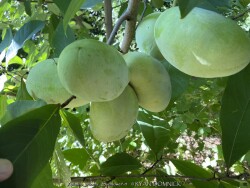

Paw Paw (Asimina triloba) is a tropical looking native understory fruit tree with large green leaves and delicious fruits. Flowers are born on old wood in the early spring and the maroon color is common of flowers meant to attract flies for pollination. Foliage is up to 12 inches long and turns a brilliant yellow in autumn for a couple weeks before falling. If cross pollination occurs, delicious fruits are produced in small clusters. The texture is custard like and taste is a mix between banana, mango, and hint of pineapple. Fruit is very fragile upon ripening and will fall to the ground and splat or be quickly devoured by animals. It is suggested that you put fruit nets around the clusters of fruit or harvest a few days earlier and allow to ripen inside. Fruit is rarely commercially available due to its fragility and short shelf-life. Cleaned fruit may be peeled frozen with seed intact: they can be picked out much easier when thawed out again Paw Paw may be eaten fresh, baked into desserts, or made into ice cream. Paw Paw is native to a large geographical area over eastern United States including Kansas. In the wild, Paw Paw grows in moist rich forest valleys in full to part shade. Best fruiting specimens can also be found on the edge of woodland or clearing in rich soil. Paw Paw tree colonies slowly spread by rhizomes and seem to occupy the forest understory sometimes for decades or centuries waiting for an opening to allow sunlight in. If a large canopy tree (such as an oak) dies or wind storm rolls through clearing a patch, new sunlight and an opening in the canopy occurs paving the way for sexual reproduction to take place (fruits) Paw Paw is somewhat tolerant of poorly drained soil's including clay but growth will be much slower. Interestingly, Paw Paws will tolerate and even need full sun when older to produce fruit. However, young saplings will quickly die in full sun from leaf burn and drought stress. If a tree is at least 4 to 6 tall and is planted in rich soil and full sun with regular irrigation, it will probably be fine. With these growing conditions, trees may grow at a median growth rate instead of slow, putting up 1 to 2 feet of new growth per year. If you have the right conditions for a Paw Paw tree, it should definitely be a part of your landscape whether you are growing for fruit production or not. There are dozens on improved cultivars available now days. In our Lawrence, KS display gardens, we are trialing several of these improved fruiting cultivars from Forrest Keeling Nursery in Missouri. Asimina triloba 'Sunflower' is a well-known, hardy selection originally from Chanute, Kansas. It ripens later than other varieties with large, flavorful fruit and is at lease partially self-fertile. Fruit has been described as tasting of mango, apricot, pineapple, banana and vanilla.


Paw Paw (Asimina triloba) is a tropical looking native understory fruit tree with large green leaves and delicious fruits. Flowers are born on old wood in the early spring and the maroon color is common of flowers meant to attract flies for pollination. Foliage is up to 12 inches long and turns a brilliant yellow in autumn for a couple weeks before falling. If cross pollination occurs, delicious fruits are produced in small clusters. The texture is custard like and taste is a mix between banana, mango, and hint of pineapple. Fruit is very fragile upon ripening and will fall to the ground and splat or be quickly devoured by animals. It is suggested that you put fruit nets around the clusters of fruit or harvest a few days earlier and allow to ripen inside. Fruit is rarely commercially available due to its fragility and short shelf-life. Cleaned fruit may be peeled frozen with seed intact: they can be picked out much easier when thawed out again Paw Paw may be eaten fresh, baked into desserts, or made into ice cream. Paw Paw is native to a large geographical area over eastern United States including Kansas. In the wild, Paw Paw grows in moist rich forest valleys in full to part shade. Best fruiting specimens can also be found on the edge of woodland or clearing in rich soil. Paw Paw tree colonies slowly spread by rhizomes and seem to occupy the forest understory sometimes for decades or centuries waiting for an opening to allow sunlight in. If a large canopy tree (such as an oak) dies or wind storm rolls through clearing a patch, new sunlight and an opening in the canopy occurs paving the way for sexual reproduction to take place (fruits) Paw Paw is somewhat tolerant of poorly drained soil's including clay but growth will be much slower. Interestingly, Paw Paws will tolerate and even need full sun when older to produce fruit. However, young saplings will quickly die in full sun from leaf burn and drought stress. If a tree is at least 4 to 6 tall and is planted in rich soil and full sun with regular irrigation, it will probably be fine. With these growing conditions, trees may grow at a median growth rate instead of slow, putting up 1 to 2 feet of new growth per year. If you have the right conditions for a Paw Paw tree, it should definitely be a part of your landscape whether you are growing for fruit production or not. There are dozens on improved cultivars available now days. In our Lawrence, KS display gardens, we are trialing several of these improved fruiting cultivars from Forrest Keeling Nursery in Missouri. Asimina triloba 'Wabash' features sweet fruit with medium firm flesh. It has excellent quality large-sized fruit with good productivity.


Paw Paw (Asimina triloba) is a tropical looking native understory fruit tree with large green leaves and delicious fruits. Flowers are born on old wood in the early spring and the maroon color is common of flowers meant to attract flies for pollination. Foliage is up to 12 inches long and turns a brilliant yellow in autumn for a couple weeks before falling. If cross pollination occurs, delicious fruits are produced in small clusters. The texture is custard like and taste is a mix between banana, mango, and hint of pineapple. Fruit is very fragile upon ripening and will fall to the ground and splat or be quickly devoured by animals. It is suggested that you put fruit nets around the clusters of fruit or harvest a few days earlier and allow to ripen inside. Fruit is rarely commercially available due to its fragility and short shelf-life. Cleaned fruit may be peeled frozen with seed intact: they can be picked out much easier when thawed out again Paw Paw may be eaten fresh, baked into desserts, or made into ice cream. Paw Paw is native to a large geographical area over eastern United States including Kansas. In the wild, Paw Paw grows in moist rich forest valleys in full to part shade. Best fruiting specimens can also be found on the edge of woodland or clearing in rich soil. Paw Paw tree colonies slowly spread by rhizomes and seem to occupy the forest understory sometimes for decades or centuries waiting for an opening to allow sunlight in. If a large canopy tree (such as an oak) dies or wind storm rolls through clearing a patch, new sunlight and an opening in the canopy occurs paving the way for sexual reproduction to take place (fruits) Paw Paw is somewhat tolerant of poorly drained soil's including clay but growth will be much slower. Interestingly, Paw Paws will tolerate and even need full sun when older to produce fruit. However, young saplings will quickly die in full sun from leaf burn and drought stress. If a tree is at least 4 to 6 tall and is planted in rich soil and full sun with regular irrigation, it will probably be fine. With these growing conditions, trees may grow at a median growth rate instead of slow, putting up 1 to 2 feet of new growth per year. If you have the right conditions for a Paw Paw tree, it should definitely be a part of your landscape whether you are growing for fruit production or not. There are dozens on improved cultivars available now days. In our Lawrence, KS display gardens, we are trialing several of these improved fruiting cultivars from Forrest Keeling Nursery in Missouri. Asimina triloba 'Wells' features large fruit up to one pound each have distinct banana-like flavor.
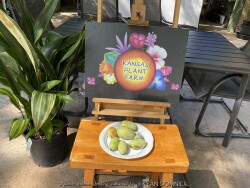

Paw Paw (Asimina triloba) is a tropical looking native understory fruit tree with large green leaves and delicious fruits. Flowers are born on old wood in the early spring and the maroon color is common of flowers meant to attract flies for pollination. Foliage is up to 12 inches long and turns a brilliant yellow in autumn for a couple weeks before falling. If cross pollination occurs, delicious fruits are produced in small clusters. The texture is custard like and taste is a mix between banana, mango, and hint of pineapple. Fruit is very fragile upon ripening and will fall to the ground and splat or be quickly devoured by animals. It is suggested that you put fruit nets around the clusters of fruit or harvest a few days earlier and allow to ripen inside. Fruit is rarely commercially available due to its fragility and short shelf-life. Cleaned fruit may be peeled frozen with seed intact: they can be picked out much easier when thawed out again Paw Paw may be eaten fresh, baked into desserts, or made into ice cream. Paw Paw is native to a large geographical area over eastern United States including Kansas. In the wild, Paw Paw grows in moist rich forest valleys in full to part shade. Best fruiting specimens can also be found on the edge of woodland or clearing in rich soil. Paw Paw tree colonies slowly spread by rhizomes and seem to occupy the forest understory sometimes for decades or centuries waiting for an opening to allow sunlight in. If a large canopy tree (such as an oak) dies or wind storm rolls through clearing a patch, new sunlight and an opening in the canopy occurs paving the way for sexual reproduction to take place (fruits) Paw Paw is somewhat tolerant of poorly drained soil's including clay but growth will be much slower. Interestingly, Paw Paws will tolerate and even need full sun when older to produce fruit. However, young saplings will quickly die in full sun from leaf burn and drought stress. If a tree is at least 4 to 6 tall and is planted in rich soil and full sun with regular irrigation, it will probably be fine. With these growing conditions, trees may grow at a median growth rate instead of slow, putting up 1 to 2 feet of new growth per year. If you have the right conditions for a Paw Paw tree, it should definitely be a part of your landscape whether you are growing for fruit production or not. There are dozens on improved cultivars available now days. In our Lawrence, KS display gardens, we are trialing several of these improved fruiting cultivars from Forrest Keeling Nursery in Missouri.
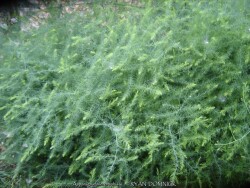

This Hardy Asparagus Fern (Asparagus microraphis) makes a wonderful extreme fine textures accent plant in the landscape. The effect is more dramatic when combined with large leaved and bold flowering hardy tropicals. Native to rocky mountain slopes in South Africa, Asparagus microraphis forms a tight bush-like perennial wider than it is tall. Interestingly, if you walk by and lightly kick the plant, the whole plant bounces and jiggles like one solid mass; things sort of "bounce off" of it. This plant is also perfectly suited to cascade down a retaining wall in the landscape. The deciduous stalks of medium green foliage turn a brilliant gold fall color. Tiny white flowers bloom in mid-May sometimes followed by red fruit. If low temperatures hit -10 degrees F, it may kill an un-mulched plant; protect any zone 6 perennial with thick layer of mulch. Unfortunately, this is how we lost our display garden plant a few years ago at -11 Degrees F. Since the foliage is evergreen to 20 degrees F or so and so mound-like, we forgot to cut it back and mulch it before a real-cold blast. Our original display garden plant came from Plant Delights Nursery in North Carolina.
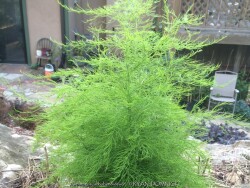

This Hardy Asparagus Fern (Asparagus schoberioides) makes a wonderful extreme fine textures accent plant in the landscape. The effect is more dramatic when combined with large leaved and bold flowering hardy tropicals. Native to Siberia, Asparagus schoberioides is perfectly suited to cascade down a retaining walls in Kansas landscapes. The tiny medium green foliage is flowing and but still dense. The golden fall color reminds me of Amsonia hubrichtii except with red berries! Tiny white flowers bloom in summer usually followed by red fruit. It survived -16 degrees F and a week of single digit highs in Lawrence, KS during February, 2021 without mulch.
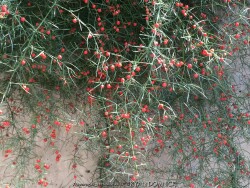

Hardy Asparagus Vine (Asparagus verticillatus) makes a wonderful extreme fine textures accent plant in the landscape. The effect is more dramatic when combined with large leaved and bold flowering hardy tropicals. Asparagus verticillatus is native to the Balkan Peninsula, Eastern Europe, Turkey, Northern Iraq, the Caucasus, Iran and Central Asia. Asparagus cochinchinensis 'Chuwang' is perfectly suited to cascade down a retaining wall in the Kansas landscape. The long twining deciduous stalks (upto 10' long) of dark green foliage turn a brilliant gold fall color. Tiny white flowers bloom in mid-May sometimes followed by loads of red fruit. The foliage stays green into the mid-20s F, serving as a perfect background for the red berries. It survived -16 degrees F and a week of single digit highs in Lawrence, KS during February, 2021 without mulch. Beautiful well-established specimens exist at the Denver Botanical Garden (zone 5b) clamoring down a 12' concrete retaining wall; what a great way to hide ugly gray concrete!
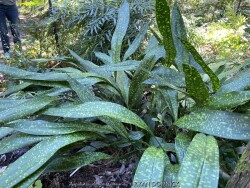

Cast-iron Plant (Aspidistra sp.) is a beautiful perennial and warmer climates for full shade. The leaves are glossy green perched on narrow stems with fat leaf blades. Unfortunately in our zone 6 Kansas climate, they cannot reliably be used as a perennial here. Most broadleaf evergreen plants are difficult to push the envelope with colder zones because evergreen leaves are more expensive to replace than for deciduous plants (slower and requires more energy from the plant). As a potted patio plant for full shade, they are wonderful. Grown in a raised pot, they are hardy to about 20-25° so you may be able to miss the first few frosts when moving them in for the winter. Before extreme cold (lower than approx.15 degrees F), they must be moved and overwintered in a dark garage or basement with monthly watering or bright window as a winter-only houseplant. Either way, they will hold up very well in the winter and maintain attractive foliage. When grown as a permanent house plant, they will last many years is grown in a bright indirect area. When Cast-iron Plant is grown as a permanent houseplant, you will need to watch for spider mites and possibly scale after a few years. Taking the whole plant outside and spraying with water a few times a year will help. Spider mites thrive and dry dusty conditions with low humidity (such as your house). Overall, Cast-iron Plants are very easy to grow hence their name. They will tolerate lower light than just about any house plant but after a few years, even this plant will decline unless given a summer growing season under a shaded tree or brighter conditions inside the house. New leaves grow about once per year and gradually the plant will need to be repotted as it is possible for them to split the container. This is a great time to divide the root system and get several new plants. This is one of our all-time favorite house plants.
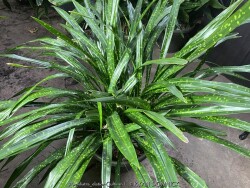

Cast-iron Plant (Aspidistra sp.) is a beautiful perennial and warmer climates for full shade. The leaves are glossy green perched on narrow stems with fat leaf blades. Unfortunately in our zone 6 Kansas climate, they cannot reliably be used as a perennial here. Most broadleaf evergreen plants are difficult to push the envelope with colder zones because evergreen leaves are more expensive to replace than for deciduous plants (slower and requires more energy from the plant). As a potted patio plant for full shade, they are wonderful. Grown in a raised pot, they are hardy to about 20-25° so you may be able to miss the first few frosts when moving them in for the winter. Before extreme cold (lower than approx.15 degrees F), they must be moved and overwintered in a dark garage or basement with monthly watering or bright window as a winter-only houseplant. Either way, they will hold up very well in the winter and maintain attractive foliage. When grown as a permanent house plant, they will last many years is grown in a bright indirect area. When Cast-iron Plant is grown as a permanent houseplant, you will need to watch for spider mites and possibly scale after a few years. Taking the whole plant outside and spraying with water a few times a year will help. Spider mites thrive and dry dusty conditions with low humidity (such as your house). Overall, Cast-iron Plants are very easy to grow hence their name. They will tolerate lower light than just about any house plant but after a few years, even this plant will decline unless given a summer growing season under a shaded tree or brighter conditions inside the house. New leaves grow about once per year and gradually the plant will need to be repotted as it is possible for them to split the container. This is a great time to divide the root system and get several new plants. This is one of our all-time favorite house plants.
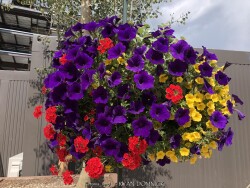

Assorted Annual Flowering Hanging Baskets offer intense color to the patio or pergola!


Annuals are planted for non-stop color to the garden or seasonal color beds!
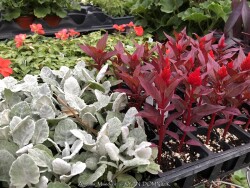

Annuals are planted for non-stop color to the garden or seasonal color beds!
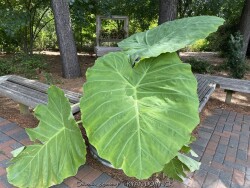

Annuals are planted for non-stop color to the garden or seasonal color beds!


Annuals are planted for non-stop color to the garden or seasonal color beds!


Succulents are usually spineless and grown for their beautiful shapes, color and texture. Cactus are known for their spines, unusual shapes and beautiful flowers. Late on the evolutionary timeline, cacti fossils are rare to non-existent. The "spines" are actually modified leaves! Cacti are native almost exclusively to the Americas, while succulents can include a much larger plant palette be from any dry area in the world. Both succulents and cacti store water in their fleshy tissues. They are usually grown as a patio or house plant in Kansas. In the wild, some species are hardy to below 0 degrees F. Grow in full sun with no extra watering except that which comes from rainfall. Repotting may or may not be needed depending on how large you want the plant to grow; plants can continue to grow taller and tolerate extremely root-bound pots but may need wind bracing. If repotting, make sure to use a sharp draining low organic cactus mix with plenty of sand and perlite. To play is safe, potted plants are best moved in before night temperatures get below 45 degrees F. It is important to avoid the combination of wet and cold. Move to a bright interior window over the winter with no watering and keep above freezing. As a winter house plant, it will look presentable all winter long with just no waterings. As a permanent house plant, provide bright light and allow the soil to dry between waterings for many years of carefree enjoyment. Plants grown permanently indoors may begin to elongate stretching for light and lose their spine color. It can be hard to reproduce the intense UV sunlight they need so moving outside for the summer is best. Generally if moving outside for the summer, allow 1-2 weeks of part shade or morning sun before placing in full sun. Plants with time to acclimate will thrive in full sun but be careful not to rush it or sunburning will occur. Potted plants are very low maintenance but watch for scale and mealybugs that may hide beneath the cover of spines.
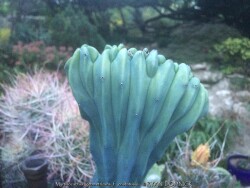

Succulents are usually spineless and grown for their beautiful shapes, color and texture. Cactus are known for their spines, unusual shapes and beautiful flowers. Late on the evolutionary timeline, cacti fossils are rare to non-existent. The "spines" are actually modified leaves! Cacti are native almost exclusively to the Americas, while succulents can include a much larger plant palette be from any dry area in the world. Both succulents and cacti store water in their fleshy tissues. They are usually grown as a patio or house plant in Kansas. In the wild, some species are hardy to below 0 degrees F. Grow in full sun with no extra watering except that which comes from rainfall. Repotting may or may not be needed depending on how large you want the plant to grow; plants can continue to grow taller and tolerate extremely root-bound pots but may need wind bracing. If repotting, make sure to use a sharp draining low organic cactus mix with plenty of sand and perlite. To play is safe, potted plants are best moved in before night temperatures get below 45 degrees F. It is important to avoid the combination of wet and cold. Move to a bright interior window over the winter with no watering and keep above freezing. As a winter house plant, it will look presentable all winter long with just no waterings. As a permanent house plant, provide bright light and allow the soil to dry between waterings for many years of carefree enjoyment. Plants grown permanently indoors may begin to elongate stretching for light and lose their spine color. It can be hard to reproduce the intense UV sunlight they need so moving outside for the summer is best. Generally if moving outside for the summer, allow 1-2 weeks of part shade or morning sun before placing in full sun. Plants with time to acclimate will thrive in full sun but be careful not to rush it or sunburning will occur. Potted plants are very low maintenance but watch for scale and mealybugs that may hide beneath the cover of spines.
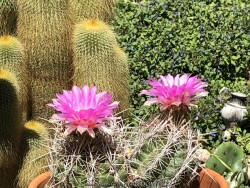

Succulents are usually spineless and grown for their beautiful shapes, color and texture. Cactus are known for their spines, unusual shapes and beautiful flowers. Late on the evolutionary timeline, cacti fossils are rare to non-existent. The "spines" are actually modified leaves! Cacti are native almost exclusively to the Americas, while succulents can include a much larger plant palette be from any dry area in the world. Both succulents and cacti store water in their fleshy tissues. They are usually grown as a patio or house plant in Kansas. In the wild, some species are hardy to below 0 degrees F. Grow in full sun with no extra watering except that which comes from rainfall. Repotting may or may not be needed depending on how large you want the plant to grow; plants can continue to grow taller and tolerate extremely root-bound pots but may need wind bracing. If repotting, make sure to use a sharp draining low organic cactus mix with plenty of sand and perlite. To play is safe, potted plants are best moved in before night temperatures get below 45 degrees F. It is important to avoid the combination of wet and cold. Move to a bright interior window over the winter with no watering and keep above freezing. As a winter house plant, it will look presentable all winter long with just no waterings. As a permanent house plant, provide bright light and allow the soil to dry between waterings for many years of carefree enjoyment. Plants grown permanently indoors may begin to elongate stretching for light and lose their spine color. It can be hard to reproduce the intense UV sunlight they need so moving outside for the summer is best. Generally if moving outside for the summer, allow 1-2 weeks of part shade or morning sun before placing in full sun. Plants with time to acclimate will thrive in full sun but be careful not to rush it or sunburning will occur. Potted plants are very low maintenance but watch for scale and mealybugs that may hide beneath the cover of spines.
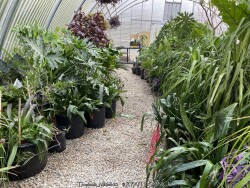

***Description for this plant available with future update!***


***Description for this plant available with future update!***
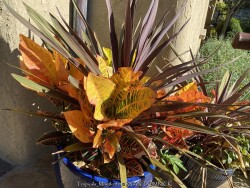

***Description for this plant available with future update!***
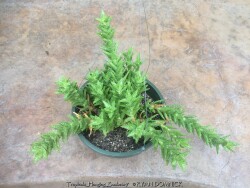

***Description for this plant available with future update!***
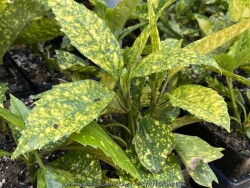

Japanese Aucuba (Aucuba japonica) is a surprisingly hardy evergreen shrub from Japan featuring dark green leaves with gold spots. Flowering and fruiting may occur in warmer climates but have not witnessed that in our zone 6a climate. Aucuba is at the northern edge of its range but will survive and reach varying heights of 1 to 3 feet. Winterkill occurs at about -5 to -10° so plan to prune off winter kill and new growth will resume in spring. In southern zones with mild winters aucuba can reach 6-8' tall, tolerating full shade and drought making it a great dry shade plant. In our Lawrence Gardens, this is possible if sited on a south exposure in full shade with winter wind protection. Rich organic soils and morning sun / filtered sun are both preferred in northern climates. Watering during the winter when dry will help broadleaf evergreen shrubs stay hydrated and maintain their winter foliage better. This jewel of the shade garden adds valuable bright green and yellow winter color giving some structure. Combine with other shade plants such as hosta, Solomon Seal, Hellebore, Barrenwort, or Coralberry. Plants in our Lawrence, KS gardens generally survive for several years and are worth the effort in the shade garden. Don't count on them getting very big so plant close together if designing with a grouping. Aucuba japonica 'Gold King' is a male form with numerous gold spots on dark green leaves.
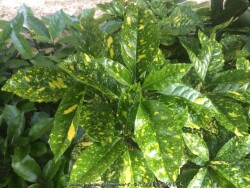

Japanese Aucuba (Aucuba japonica) is a surprisingly hardy evergreen shrub from Japan featuring dark green leaves with gold spots. Flowering and fruiting may occur in warmer climates but have not witnessed that in our zone 6a climate. Aucuba is at the northern edge of its range but will survive and reach varying heights of 1 to 3 feet. Winterkill occurs at about -5 to -10° so plan to prune off winter kill and new growth will resume in spring. In southern zones with mild winters aucuba can reach 6-8' tall, tolerating full shade and drought making it a great dry shade plant. In our Lawrence Gardens, this is possible if sited on a south exposure in full shade with winter wind protection. Rich organic soils and morning sun / filtered sun are both preferred in northern climates. Watering during the winter when dry will help broadleaf evergreen shrubs stay hydrated and maintain their winter foliage better. This jewel of the shade garden adds valuable bright green and yellow winter color giving some structure. Combine with other shade plants such as hosta, Solomon Seal, Hellebore, Barrenwort, or Coralberry. Plants in our Lawrence, KS gardens generally survive for several years and are worth the effort in the shade garden. Don't count on them getting very big so plant close together if designing with a grouping. Aucuba japonica 'Marmorata' is a female form with numerous gold blotches on dark green leaves.


The False Indigo species (Baptisia) features beautiful compact bluish green leaves arranged in groups of three. Like many members in the legume family, they are nitrogen fixing plants which means they produce their own nitrogen in the soil through a symbiotic relationship with bacteria. The flowers bloom above the foliage normally in April and May. Common baptisia flower colors include white, purple, lavender, yellow, and pink as well as uncommon colors ranging from deep purple to maroon and even coppery orange. Considered a great North American native three season plant, the foliage always emerges very attractive followed by flowers that do not need deadheading. Foliage generally lasts pretty nice through hot summers and into fall turning black with first freeze. Seed pods also turn charcoal black when ripe and have considerable ornamental interest and useful in dried flower arrangements. At some point in the fall, it can be cut down early for a clean look or left for winter interest. Baptisia generally do well in droughty clay soils in full to part sun. There is only one pest that may create problems called the Genista Broom Moth. It may occur in Kansas when weather conditions are consistently dry and over 95 degrees F. It is treatable if you act fast but if not, it only destroys the foliage late in the season and does not kill the plant. Baptisia has several enormous spreading taproots which store water and energy and can make transplanting difficult. Plantings look good as specimen or in small groups; and it's ok even preferable if they grow together and touch other plants. That helps eliminate available sunlight and discourages weeds. It is hard to picture a native plant garden or any perennial garden without Baptisia. Considered a once "it's there, it's always there" plant. Baptisia 'American Goldfinch' >>>>>>>Gorgeous, golden yellow flower spikes rise up above its wide habit. This is one of the most floriferous Baptisia we offer, producing loads of brightly colored spikes for many weeks. After the blooming season, 'American Goldfinch' produces attractive round seed pods in the fall. This is the perfect specimen for filling in a large space in your garden or for mass plantings in landscapes. >>>>> This extremely long-lived perennial could be used instead of a shrub in landscape settings, with minimal care required to thrive year after year.


The False Indigo species (Baptisia) features beautiful compact bluish green leaves arranged in groups of three. Like many members in the legume family, they are nitrogen fixing plants which means they produce their own nitrogen in the soil through a symbiotic relationship with bacteria. The flowers bloom above the foliage normally in April and May. Common baptisia flower colors include white, purple, lavender, yellow, and pink as well as uncommon colors ranging from deep purple to maroon and even coppery orange. Considered a great North American native three season plant, the foliage always emerges very attractive followed by flowers that do not need deadheading. Foliage generally lasts pretty nice through hot summers and into fall turning black with first freeze. Seed pods also turn charcoal black when ripe and have considerable ornamental interest and useful in dried flower arrangements. At some point in the fall, it can be cut down early for a clean look or left for winter interest. Baptisia generally do well in droughty clay soils in full to part sun. There is only one pest that may create problems called the Genista Broom Moth. It may occur in Kansas when weather conditions are consistently dry and over 95 degrees F. It is treatable if you act fast but if not, it only destroys the foliage late in the season and does not kill the plant. Baptisia has several enormous spreading taproots which store water and energy and can make transplanting difficult. Plantings look good as specimen or in small groups; and it's ok even preferable if they grow together and touch other plants. That helps eliminate available sunlight and discourages weeds. It is hard to picture a native plant garden or any perennial garden without Baptisia. Considered a once "it's there, it's always there" long lived plant. Baptisia 'Blue Bubbly' is a lavender-blue flowering tall variety. Its vase-like habit is topped with densely packed, blue flowers. The long, 16" flower spikes make for an extended season of bloom. This extremely long-lived perennial could be used instead of a shrub in landscape settings, with minimal care required to thrive year after year. This plant is a member of the DECADENCE® DELUXE series from Walters Gardens, Inc.
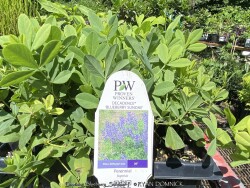

The False Indigo species (Baptisia) features beautiful compact bluish green leaves arranged in groups of three. Like many members in the legume family, they are nitrogen fixing plants which means they produce their own nitrogen in the soil through a symbiotic relationship with bacteria. The flowers bloom above the foliage normally in April and May. Common baptisia flower colors include white, purple, lavender, yellow, and pink as well as uncommon colors ranging from deep purple to maroon and even coppery orange. Considered a great North American native three season plant, the foliage always emerges very attractive followed by flowers that do not need deadheading. Foliage generally lasts pretty nice through hot summers and into fall turning black with first freeze. Seed pods also turn charcoal black when ripe and have considerable ornamental interest and useful in dried flower arrangements. At some point in the fall, it can be cut down early for a clean look or left for winter interest. Baptisia generally do well in droughty clay soils in full to part sun. There is only one pest that may create problems called the Genista Broom Moth. It may occur in Kansas when weather conditions are consistently dry and over 95 degrees F. It is treatable if you act fast but if not, it only destroys the foliage late in the season and does not kill the plant. Baptisia has several enormous spreading taproots which store water and energy and can make transplanting difficult. Plantings look good as specimen or in small groups; and it's ok even preferable if they grow together and touch other plants. That helps eliminate available sunlight and discourages weeds. It is hard to picture a native plant garden or any perennial garden without Baptisia. Considered a once "it's there, it's always there" long lived plant. Baptisia 'Blueberry Sundae' features deep indigo blue flowers much more vibrant than the original species B. australis. The deep blue-green foliage forms a more compact, upright mound to 3' tall at maturity. 'Blueberry Sundae' is a vigorous grower and the foliage looks great all summer. Ornamental seed pods extend the season of interest into fall. This plant is a member of the DECADENCE® series from Walters Gardens, Inc.
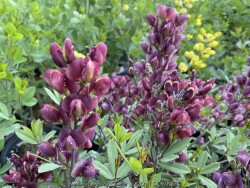

The False Indigo species (Baptisia) features beautiful compact bluish green leaves arranged in groups of three. Like many members in the legume family, they are nitrogen fixing plants which means they produce their own nitrogen in the soil through a symbiotic relationship with bacteria. The flowers bloom above the foliage normally in April and May. Common baptisia flower colors include white, purple, lavender, yellow, and pink as well as uncommon colors ranging from deep purple to maroon and even coppery orange. Considered a great North American native three season plant, the foliage always emerges very attractive followed by flowers that do not need deadheading. Foliage generally lasts pretty nice through hot summers and into fall turning black with first freeze. Seed pods also turn charcoal black when ripe and have considerable ornamental interest and useful in dried flower arrangements. At some point in the fall, it can be cut down early for a clean look or left for winter interest. Baptisia generally do well in droughty clay soils in full to part sun. There is only one pest that may create problems called the Genista Broom Moth. It may occur in Kansas when weather conditions are consistently dry and over 95 degrees F. It is treatable if you act fast but if not, it only destroys the foliage late in the season and does not kill the plant. Baptisia has several enormous spreading taproots which store water and energy and can make transplanting difficult. Plantings look good as specimen or in small groups; and it's ok even preferable if they grow together and touch other plants. That helps eliminate available sunlight and discourages weeds. It is hard to picture a native plant garden or any perennial garden without Baptisia. Considered a once "it's there, it's always there" plant. >>>>>Baptisia 'Burgundy Blast' features dark wine purple flowers are produced over very dark blue-green foliage. When it is in bloom, it is a stunning display of color. This extremely long-lived perennial could be used instead of a shrub in landscape settings, with minimal care required to thrive year after year.
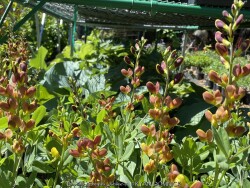

The False Indigo species (Baptisia) features beautiful compact bluish green leaves arranged in groups of three. Like many members in the legume family, they are nitrogen fixing plants which means they produce their own nitrogen in the soil through a symbiotic relationship with bacteria. The flowers bloom above the foliage normally in April and May. Common baptisia flower colors include white, purple, lavender, yellow, and pink as well as uncommon colors ranging from deep purple to maroon and even coppery orange. Considered a great North American native three season plant, the foliage always emerges very attractive followed by flowers that do not need deadheading. Foliage generally lasts pretty nice through hot summers and into fall turning black with first freeze. Seed pods also turn charcoal black when ripe and have considerable ornamental interest and useful in dried flower arrangements. At some point in the fall, it can be cut down early for a clean look or left for winter interest. Baptisia generally do well in droughty clay soils in full to part sun. There is only one pest that may create problems called the Genista Broom Moth. It may occur in Kansas when weather conditions are consistently dry and over 95 degrees F. It is treatable if you act fast but if not, it only destroys the foliage late in the season and does not kill the plant. Baptisia has several enormous spreading taproots which store water and energy and can make transplanting difficult. Plantings look good as specimen or in small groups; and it's ok even preferable if they grow together and touch other plants. That helps eliminate available sunlight and discourages weeds. It is hard to picture a native plant garden or any perennial garden without Baptisia. Considered a once "it's there, it's always there" long lived plant. >>>>>Baptisia 'Cherries Jubilee' features deep maroon buds open to bicolor maroon and yellow flowers held on strong scapes above the blue-green foliage in late spring to early summer. Secondary branching on the flower stems makes this variety especially floriferous. As the flowers age, they turn gold creating the bi-color effect! This extremely long-lived perennial could be used instead of a shrub in landscape settings, with minimal care required to thrive year after year.>>>>>This plant is a member of the DECADENCE® series from Walters Gardens, Inc.